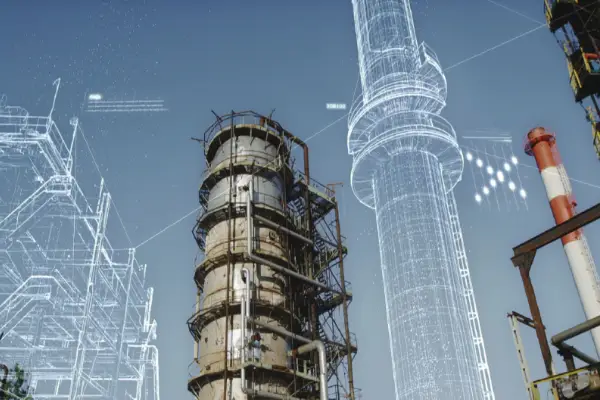
Transforming the Oil and Gas Industry with BIM
Building Information Modeling (BIM) has been a game-changer in the construction and architecture industries, offering a digital representation of physical and functional characteristics of facilities. However, its transformative potential extends far beyond traditional construction, reaching into the oil and gas industry.
BIM can revolutionize the way oil and gas projects are planned, executed, and managed, enhancing efficiency, safety, and sustainability. This article explores how BIM for oil and gas industry is transforming the energy sector.
Understanding BIM
BIM involves the creation and management of digital models that encompass the physical and functional aspects of a facility. These models are highly detailed and include information about the geometry, spatial relationships, geographic information, quantities, and properties of building components. BIM facilitates better collaboration among stakeholders, improves decision-making, and enhances project outcomes. By providing a comprehensive digital representation of a facility, BIM helps stakeholders visualize the entire project lifecycle, from design to construction to operations and maintenance.
The Oil and Gas Industry Landscape
The oil and gas industry is complex and capital-intensive, involving extensive infrastructure, rigorous safety standards, and stringent regulatory requirements. Projects in this sector, such as offshore platforms, refineries, and pipelines, require meticulous planning and execution. Traditionally, these projects have relied on 2D drawings and documents, which can lead to inefficiencies, errors, and delays. BIM for oil and gas offers a comprehensive solution to these challenges, enabling a more integrated and efficient approach to project management.
BIM for Oil And Gas Industry
BIM can transform the oil and gas industry in several ways:
Improved Planning and Design
BIM allows for the creation of highly detailed 3D models that provide an accurate representation of oil and gas facilities. This helps in better visualization and understanding of the project during the planning and design phases. Engineers and designers can use these models to identify potential issues early, optimize designs, and ensure that all components fit together seamlessly.
This reduces the likelihood of costly changes and rework during construction. Furthermore, BIM facilitates the integration of various disciplines, such as structural, mechanical, and electrical engineering, ensuring a holistic approach to design.

Enhanced Collaboration and Communication
Oil and gas projects involve multiple stakeholders, including engineers, architects, contractors, and operators. BIM serves as a central repository of information, facilitating better collaboration and communication among these stakeholders.
The shared BIM model ensures that everyone is working with the same data, reducing misunderstandings and enhancing coordination. This collaborative approach leads to more efficient project execution and better overall outcomes. Additionally, cloud-based BIM platforms enable real-time access to project information, allowing stakeholders to collaborate effectively, regardless of their physical location.
Better Project Management
BIM offers powerful tools for project management. The digital models can be used to simulate different construction scenarios, evaluate the impact of changes, and optimize schedules. BIM also supports the integration of time (4D) and cost (5D) dimensions, providing a comprehensive view of the project timeline and budget.
This enables project managers to make informed decisions, track progress, and mitigate risks effectively. Moreover, BIM facilitates the integration of project management software, such as Primavera and Microsoft Project, allowing for seamless data exchange and improved project control.
Increased Safety
Safety is a paramount concern in the oil and gas industry. BIM enhances safety by enabling detailed planning and risk assessment. The 3D models can be used to identify potential hazards, plan safe work procedures, and ensure compliance with safety regulations. Additionally, BIM supports the creation of virtual reality (VR) simulations, allowing workers to practice complex tasks in a safe, controlled environment.
This reduces the risk of accidents and improves overall safety performance. Furthermore, BIM enables the integration of safety management systems, providing a comprehensive approach to hazard identification, risk assessment, and mitigation.
Sustainability and Environmental Compliance
BIM helps oil and gas companies achieve sustainability and environmental compliance. The detailed digital models enable better analysis of energy consumption, emissions, and environmental impact. This information can be used to optimize designs, select sustainable materials, and implement energy-efficient systems.
BIM also supports compliance with environmental regulations by providing accurate documentation and facilitating transparent reporting. Additionally, BIM enables the integration of environmental management systems, such as ISO 14001, ensuring a systematic approach to environmental performance improvement.
Efficient Maintenance and Operations
The benefits of BIM extend beyond the construction phase. The digital models serve as a valuable resource for maintenance and operations. They provide detailed information about the facility’s components, systems, and equipment, supporting efficient maintenance planning and execution.
BIM also enables predictive maintenance by integrating with sensors and monitoring systems, allowing for early detection of issues and reducing downtime. This enhances the reliability and longevity of oil and gas facilities. Furthermore, BIM facilitates the integration of asset management systems, such as ISO 55000, providing a comprehensive approach to asset lifecycle management.
Conclusion
BIM is transforming the oil and gas industry by enhancing planning and design, improving collaboration and communication, optimizing project management, increasing safety, promoting sustainability, and supporting efficient maintenance and operations. As the industry continues to embrace digital transformation, the adoption of BIM will become increasingly critical, driving innovation and excellence in oil and gas projects.
The successful implementation of BIM requires a strategic approach, investment in technology and training, and a commitment to continuous improvement. By leveraging the power of BIM, oil and gas companies can achieve significant benefits, enhance project performance, and ensure long-term success.
If you are looking for BIM consultancy to make your practice more efficient in terms of cost and time, book your free consultation with us today!

